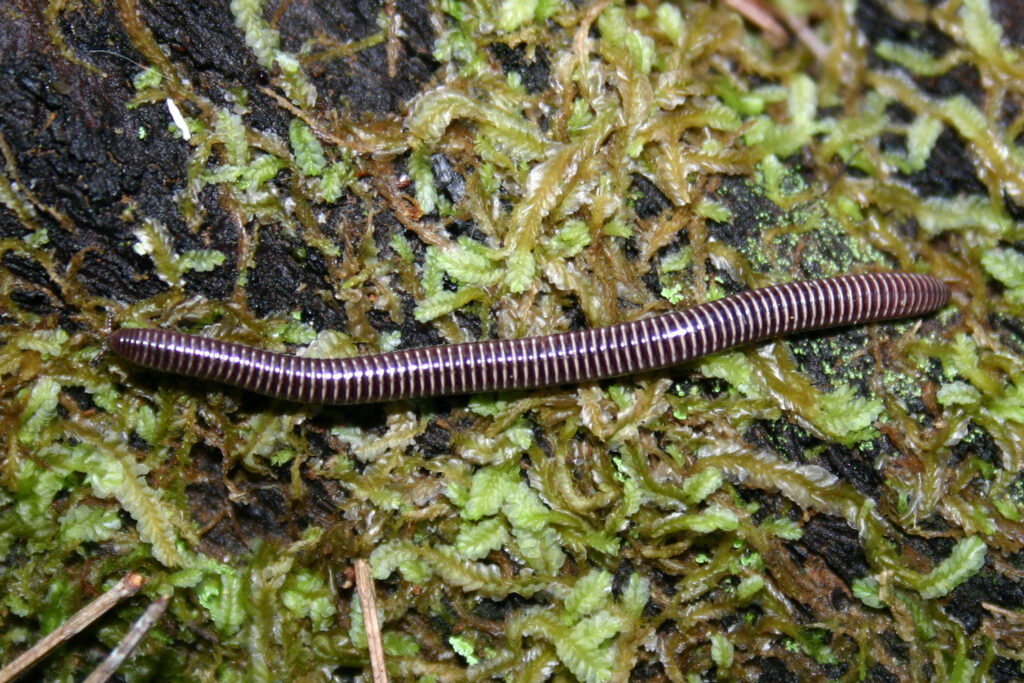
The leggiest animal on the planet, Eumillipes persephone Marek, 2021 with 1,306 legs.
In September 2020, I received an email from Bruno Buzatto in Perth, Australia, about a millipede that he and his colleagues found in Western Australia. He explained that it was thin and long and had close to 200 segments. He attached an image of the animal. Familiar with millipedes with many legs—like the previous record holder of leggiest animal Illacme plenipes Cook & Loomis, 1928—I was immediately interested and closely examined Bruno’s images. At first glance, the millipede appeared to be a relative of I. plenipes in the order Siphonophorida and family Siphonorhinidae. This quick image-based determination was based on the the millipede’s narrow thread-like body, lack of eyes and pigmentation, cone-shaped head, and enlarged antennae. I did a quick count of my own from Bruno’s image, and it appeared to have 204 segments and 806 legs, which is more than the 192 segments and 750 legs of the previous record holder, I. plenipes. Recognizing that it was something new and really exciting, I explained that I would be very interested in examining specimens in detail.
After depositing the specimens in the Western Australian Museum and introducing me to the museum’s arachnids and myriapods curator, Mark Harvey, the specimens were shipped to my laboratory at Virginia Tech. Mark, an arachnologist and expert in the subterranean invertebrate diversity of Western Australia, also shipped some extra specimens of Siphonophorida, including Australian siphonophorids and the South African siphonorhinid, Nematozonium filum Verhoeff, 1939—the supposed Old World relative of I. plenipes.

Eumillipes persephone, ventral view of legs (male holotype, T147101)
Waiting for the specimens to clear customs, U.S. Fish and Wildlife approval, and arrive in Blacksburg, I studied the diversity and distribution of the order Siphonophorida in Australia, and was reminded that although the family Siphonophoridae occurs in Australia, the Siphonorhinidae are not known to occur there. I knew that the country has many undescribed genera and species of the order Polyzoniida, but these known members of this family have eyes, dark pigmentation (many even with longitudinal or transverse yellow or white stripes), and are relatively flat and wide. They also occur on the surface, and no subterranean members of the order were known to occur in Australia.

An undescribed genus and species of surface-dwelling polyzoniidan millipede from Walpole, Australia with 90 segments (family Siphonotidae)
Once the specimens arrived, and I looked at them with my stereomicroscope, they immediately looked like something that I have never seen before. Its small conical head, smooth dorsal surface of its segments, large antennae with equally sized antennomeres, and ozopores (chemical defense gland openings) set in far from the lateral edges, indicated that this was an extremely odd member of the order Polyzoniida. Previously, there had been no (known) members of the order without eyes, and there was no evidence of any ocular structures on the head of this millipede.
The specimens were long, thin, and coiled up like watch springs. I carefully uncoiled the specimens, photographed them, and counted segments. I selected the longest one to count first, and to my amazement, it possessed a phenomenal 330 segments and 1,306 legs.

Eumillipes persephone male specimen T147101, ventral view of segments 1-9 and dorsal view of cone-shaped head.

Anteriormost 66 segments of a female paratype of E. persephone with 330 rings and 1,306 legs.
Eumillipes persephone also features:
- A very long body for its very narrow width. Its dimensions are about the width of sewing thread (0.95 mm) and as long as your fist (95.7 mm).
- Females are wider, longer, and have more legs than males. The leggiest male has 208 segments, 818 legs, and is 0.92 mm X 54.7 mm. Females must be larger to store eggs. (Sperm is small.)
- Hatchling millipedes emerge from the egg with eight legs, and continuously add segments during development for an indeterminate period of time, even after adulthood is attained, in a developmental process called euanamorphosis.
- Members of the order Polyzoniida, including E. persephone, generate chemical defenses composed of alkaloids, which they ooze from ozopores lining the length of their body. The 1,306 legged female has 652 ozopores that can each ooze a liquid alkaloid-based defense against predation.
Other analyses in the study included imaging specimens with a scanning electron microscope, and sequencing genomes of E. persephone and other millipedes in the group Colobognatha to show that super-elongation (having more than 180 body segments) evolved repeatedly in the millipede class Diplopoda.
Marek, P. E., Buzatto, B. A., Shear, W. A., Means, J. C., Black, D. G., Harvey, M. S., & Rodriguez, J. (2021). The first true millipede—1306 legs long. Scientific Reports, 11(1), 1-8. https://www.nature.com/articles/s41598-021-02447-0

Sheoak shrubland on the surface of Eumillipes persephone habitat

